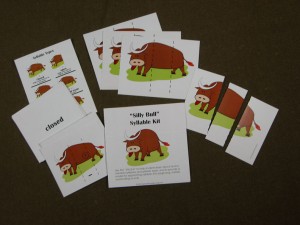It is important for students to understand how syllables are segmented into beginning, vowel and ending sounds. They need to know how to take them apart for reading, and put them together for spelling. We show students what this looks like in the blending drill by having the sounds on separate cards. But do you explicitly explain this to your student, or show them how to apply this concept in other aspects of the lesson? You can not only strengthen this association of segmentation in the blending drill, but also carry it throughout the entire lesson, by adding a visual component representing the “parts”.
To help students visualize the “beginning”, “middle” and “ending” parts, I like using Silly Bulls from the Silly Bull Kit.
Each Silly Bull is a picture of the animal divided into a head, body and tail part. (If you don’t have Silly Bulls, you can make your own cards using a picture of an animal, dinosaur, etc. Just make sure the head is on the left, the tail is on the right, and that it can be separated into a distinct head, body and tail when it’s cut apart.) The head represents a syllable’s beginning sound, the body represents its vowel sound, and the tail corresponds to the ending sound.
You can then use these visual cues throughout the lesson to connect letters to the body parts to help students see how it all fits together. Note that if you have more than one syllable, you will need more than one Silly Bull, since each syllable has its own beginning, middle and ending parts. Two syllables? Two Silly Bulls!
Students can begin to see that the body parts they put together in the blending drill are the exact same ones they use to sound out review words, which are the same ones they put together to spell. The Silly Bull body parts provide that continuity, as well as a visual reference for students to map the letters. It also gives you a handy way of referring to specific part of the word (what’s the head say, check the tail, etc.)
In the next few posts, we’ll look at the details of how you can put this idea into practice!
This post is the first in a series of articles on how to get the most out of your Silly Bull Kit:
Silly Bulls: head-body-tail segmentation (you are here!)
Silly Bulls and the Blending Drill
Silly Bull Syllable Type Cards
Silly Bulls and Introducing New Concepts

